Episode #385: Boost Math Participation & Discourse with These Simple Math Routines
LISTEN NOW HERE…
WATCH NOW…
Fresh from the 2025 NCTE-NCTM conference in Chicago, our team reflects on one powerful math instructional routine that stood out—an approach that sparked ideas for both classroom practice and professional learning design. In this episode, we highlight a key move from Annie Forest’s session, rooted in the cooperative learning strategies of Spencer Kagan, that helped create a clear balance between doing the math and taking away something concrete to implement tomorrow.
You’ll hear how this routine can help get more students engaged in meaningful math conversations—and how our team is now planning to use it in future PD sessions to foster better participation, collaboration, and implementation.
In this episode, you’ll discover:
- A practical routine that increases equitable participation in math classrooms
- How to balance student engagement with meaningful math thinking
- Ideas for applying this protocol in your own PD planning and facilitation
- Why connecting action with reflection boosts implementation
- How professional learning can model the classroom practices we want to see
Attention District Math Leaders:
Not sure what matters most when designing math improvement plans? Take this assessment and get a free customized report: https://makemathmoments.com/grow/
Ready to design your math improvement plan with guidance, support and using structure? Learn how to follow our 4 stage process. https://growyourmathprogram.com
Looking to supplement your curriculum with problem based lessons and units? Make Math Moments Problem Based Lessons & Units
Be Our Next Podcast Guest!
Join as an Interview Guest or on a Mentoring Moment Call
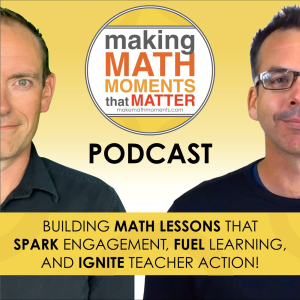
Apply to be a Featured Interview Guest
Book a Mentoring Moment Coaching Call
Are You an Official Math Moment Maker?
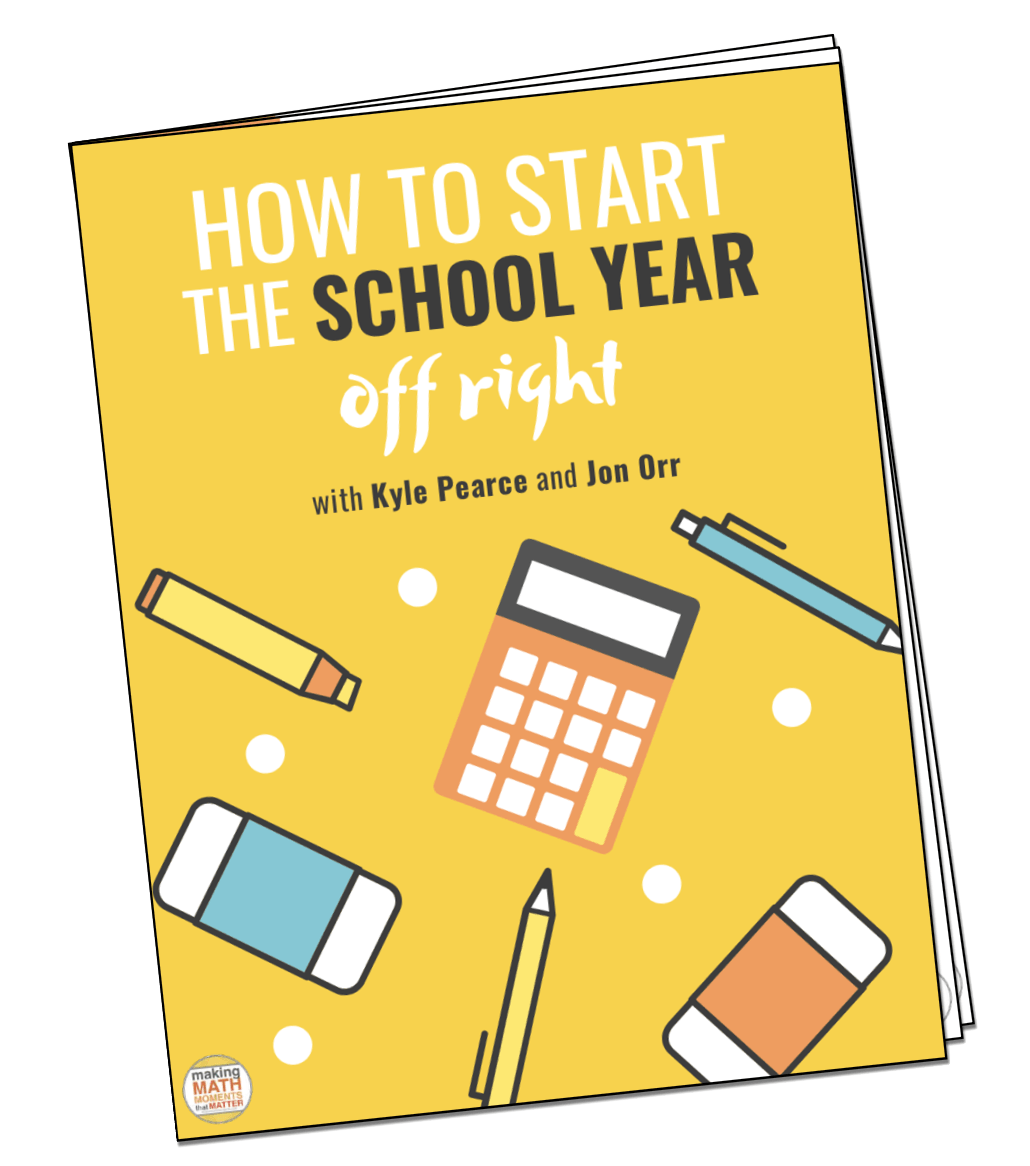
FULL TRANSCRIPT
Yvette Lehman: So I just got back from Chicago. I was fortunate to be able to attend the NCTE-NCTM joint conference and I loved it. I was telling you John yesterday, I really enjoyed the conference. I liked the format. I liked the location. There was really nothing that I would change about it. I thought it was really well done. One of the things that I loved about this particular conference was that there were different, the sessions were all different lengths.
So it’s like you had a 30 minute session, a 60 minute session, a 75 minute session. And I loved it because it allowed me to curate a learning experience throughout the day that was different. Like I need that breakup in my day. So it’s like knowing I was going into a 75, but then there was going to be a 30 after. I just, thought it was great. And I also liked the venue because sometimes we go to these conferences and I feel like I’m…
trying to run across a massive conference center because the session I want to see in the next time slot is on the absolute other side of the venue where this was all up and down the elevator. There wasn’t a single session that I missed because of the actual layout of the conference. So in this episode, with all that being said about my positive experience with that conference, I wanted to just share with you my favorite session and what I learned. Okay.
So I went to a session with Annie Forrest, who is a consultant from the Illinois area. And I can’t remember the exact title, but it was well attended because it had an interesting title, which you always say is so key to getting people to your session, right? You need a title that’s going to pique their interest. It was something about when math instructional routines go wrong or when they don’t work. And so although in the session we unpacked some of the ways that
we don’t set ourselves up for success when we’re implementing instructional routines. What I loved about the session is that we actually did them. Like I had such a positive experience because we always talk about ourselves, about the importance of getting to the math, which is something that in my own session at the conference, I got to the math, but what I didn’t do is build in instructional routines into the room.
Like how in hindsight, thought, why didn’t I build in these types of routines to
Jon Orr: Like you wouldn’t you’re saying you didn’t model the lesson as if you were you were you were using routines that you would want them to use if they were giving the lesson.
Yvette Lehman: Exactly. Well, and not even, not even the lesson necessarily, because oftentimes we go to sessions and we model, let’s say a three-part math lesson and we put them in the experience of the student. But these were more routines where it’s like, okay, we’ve just, so I, in my session, I had people doing the work, right? They were at their table. It was very much, I was facilitating, I wasn’t monologuing. It was a very interactive session.
But then I could have said, okay, now we’re gonna get into an instructional routine where we’re gonna, and I’ll share one that’s a perfect example of this. We’re gonna move around the room. This is what it’s going to look like. This is how you’re going to interact during this routine to try to build structure into the room to support cooperation and collaboration. So with all that said, I had a lot to say there. I’m gonna give you a concrete example to unpack.
So Annie mentioned that a lot of the routines that she was highlighting were from Spencer Kagan’s cooperative learning structures. So if anybody wants to reference, you know, the original research around these cooperative learning structures, so picture me, I’m in a session and we go to do this protocol that’s called quiz quiz trade. Okay. So we all have cue cards and our cue card has some type of prompt on the front.
Okay, the ones that we were doing were algebraic. So essentially I had one that mine was four plus an unknown quantity equals negative eight. That was my card. On the back of my card, I had the solution and a bit of an explanation for the solution to my own card. But before we started that experience, she gave us an instructional routine called stand up, hand up, partner up.
Okay, so picture this, I stand up. If I put my hand up, that means I don’t have a partner and I’m looking for somebody. Once I make eye contact with another person with their hand up, we become pairs. Okay, that person and I engage in our quiz quiz trade situation. So basically my partner held up his card and I talked to him through my solution and we agreed on my solution.
He then looked at my equation. He gave me his explanation for his solution. And what was fascinating is that his initial response was incorrect, which was awesome. Like I was, it was like almost more interesting because then we got to talk through. I was like, I was like, I’m not convinced, you know, and I was being careful with my language. Cause of course that’s intimidating. I’ve just met this person for the very first time. So we talked through, okay, we think it says, well, how
Can we prove that it’s not? We modeled together. But what was really cool is that once he and I were done, we traded carts. But we probably took twice as long as everybody else. But then you look around the room for who else has a hand up. So it’s not like we had to wait for every partnership in the room to finish their quiz quiz trade, because as soon as you and your partner were done, your hand goes up. So now,
Kyle Pearce: Mm. And then it’s just like fluid. You just see. Yeah. I love it.
Jon Orr: I like it. it, you know, what reminded, because I really, original, you know, the original premise of the structure reminded me of a routine I regularly use, which was the appointment clock structure.
Like where I think where originally like when you were explaining this, my mind immediately went to like the appointment clock structure where kids were, you know, had this clock and they had to like go around the room and make appointments for each other and say, Hey, are you open at 12 o’clock? Are you open at 12 o’clock? And they would fill their appointments up, which was basically them creating partner scenarios. And they had their question and they had to do their solution and then we would then call.
Kyle Pearce: So where my mind goes, and we’ve all done some of these types of partnering activities, but the part I’m really liking, and I know John used to be a big fan of the appointment clock. Kids are going around and finding different times on their clock to partner up. But as you can imagine, you do run into some roadblocks with some of those structures where you’re looking around and you can’t find someone who has 3 o’clock open on their clock.
and now you’re running around and that can be fun. But here I like that it’s fluid. Like so you may and I’m extrapolating a little bit here, but with this particular routine, it sounds to me like knowing you and knowing how you would want to go down the rabbit hole with like, you know, convincing you or your partner on the solution, you might make it to less partners than say someone else in the room who’s like done double the partnerships. However,
That sounds like pretty awesome. Like it sounds very differentiated in the sense that you aren’t feeling rushed. You’re not feeling like this is the other part too. When we use things like timers and we say, everyone, you know, for two minutes, you have two minutes to share. And some people are getting cut off. Some people are done early and they’re just kind of waiting and lingering. And in this particular scenario, it sounds like, know what you go until
The conversations may be no longer fruitful, productive, useful, helpful, whatever it might be, and then you’re right back at it. And in my mind, there should always be two more hands up, correct? Assuming you’re not going back to the same person. So I love it.
Yvette Lehman: Yeah, it was such a cool structure. And in the session, Annie talked about when we’re looking at different structures to implement, we need to look at the ratio of doing and not doing. Like how many kids are not doing anything in the structure that I’ve implemented?
Kyle Pearce: This is like sports. I always say at a sports practice where it’s like, this is a drill that only two kids are doing something at a time, and everybody else is standing waiting. And that happens a whole lot in our classrooms. And I would also say there’s probably this other element there too of like, sometimes there’s like flair and flash factor. So for example, if we have the appointment clock,
You know, we might have to print out these appointment clocks or the kids have to draw out the appointment clock. Or when you think of just how fast or how quickly or efficiently we can get the actual routine going, I think that’s a really important aspect as well. Like it’s got to be quick enough to understand and do, but it also had to be quick enough to start and finish so that we’re not like losing additional time in our classroom to, you know, unnecessary parts of the routine that we could clean up.
Yvette Lehman: It was great. So then my reflection on my own session was what could I have done as far as implementing an instructional routine that would have strengthened our internalization of the, I was focused on content, right? I was actually explicitly teaching a mathematical concept and my focus was division, but how could I have embedded routines so that they could not only
continue to internalize the learning from the day, but then even if they walked away and they weren’t confident about partitive and quotative division, they would have that routine to take with them.
Kyle Pearce: Right, right. So there is a win and there is something there that they can walk away with. I love that. And I know so well how when you are presenting an idea, especially as you continue to learn and you’re learning new ideas. And of course, as presenters, we want to present those newer ideas because they’re top of mind. We’re excited about them. We’re eager to share. Sometimes we end up glossing over some of the things that aren’t maybe as
interesting or or are quote unquote old and sometimes we sort of like fast forward through some of those things assuming everyone’s been on the same learning journey as you the presenter and I think that’s a really really important aspect and I think this also bridges something we’ve been talking a lot about where oftentimes we we highlight that a lot of professional development is like solely focused on pedagogical moves
And we’ve been talking a lot about the content piece. And really this is a great example of trying to bridge those two together because again, we don’t want it to just be content or just be pedagogy. How can we kind of bring those two things together? And I think, you know, this session is something that sort of has you thinking differently, but then also has us thinking differently as we prepare for some of our summer workshops that we’ll be doing with educators in different parts of North America.
Yvette Lehman: Yeah, for sure. It definitely was a great opportunity for me because like you said, although I, the session was on instructional routines and how we can implement them in our classroom to ensure more engagement and cooperative learning, we did the math. And we always say, you know, math PD should have math.
as a key component of the experience. So this was a perfect blending of the two, thought. So shout out to Annie for running such a awesome session. was my favorite of the, you know, many, awesome sessions. That was the one that I think left me feeling the most inspired for change.
Kyle Pearce: Mm, love it. Love it. Well, that is fantastic. Thanks for giving us that rundown. And Annie, keep on rocking. friends, note on this note, we are actually actively in the planning process for the virtual summit coming up this fall. So if you’ve never been a part of the virtual summit, you should head over to makemathmoments.com forward slash summit and get your name there for this free event. We are super geeked and jazzed. If you have something
that you think is worth sharing with the math world, then you should be heading over to that summit page as well and submitting a proposal. We are always looking to amplify the voices of other math educators and leaders from around North America and around the world. So hopefully we will see you at the virtual summit this November, 2025.
Thanks For Listening
- Book a Math Mentoring Moment
- Apply to be a Featured Interview Guest
- Leave a note in the comment section below.
- Share this show on Twitter, or Facebook.
To help out the show:
- Leave an honest review on iTunes. Your ratings and reviews really help and we read each one.
- Subscribe on iTunes, Google Play, and Spotify.
DOWNLOAD THE 3 ACT MATH TASK TIP SHEET SO THEY RUN WITHOUT A HITCH!
Download the 2-page printable 3 Act Math Tip Sheet to ensure that you have the best start to your journey using 3 Act math Tasks to spark curiosity and fuel sense making in your math classroom!
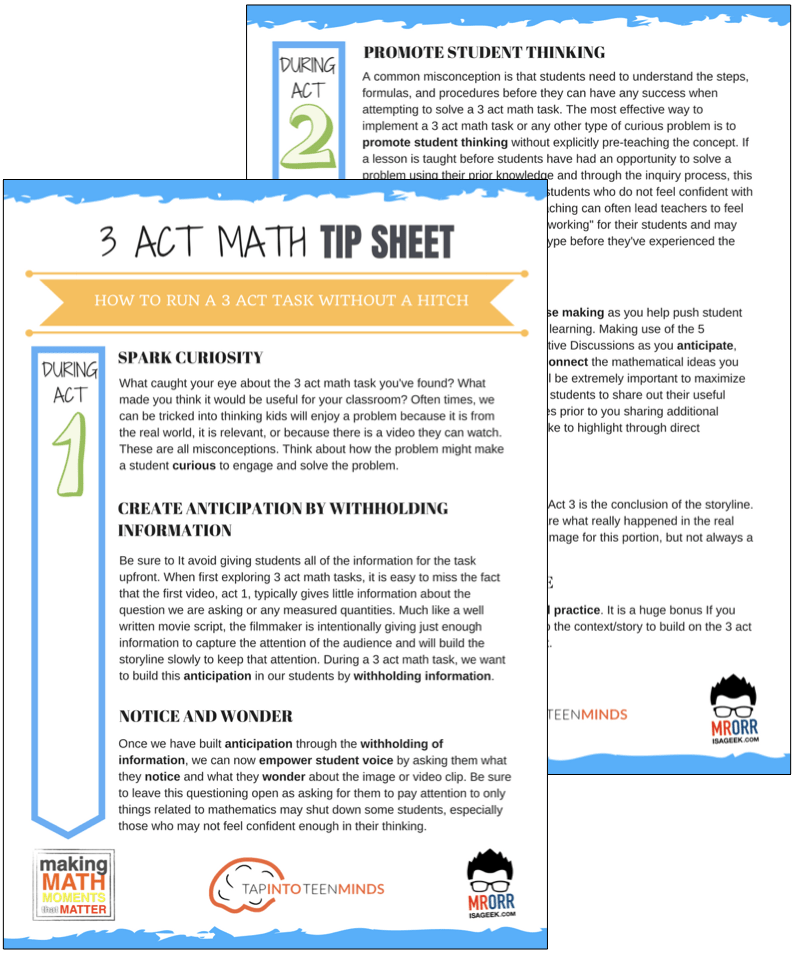
LESSONS TO MAKE MATH MOMENTS
Each lesson consists of:
Each Make Math Moments Problem Based Lesson consists of a Teacher Guide to lead you step-by-step through the planning process to ensure your lesson runs without a hitch!
Each Teacher Guide consists of:
- Intentionality of the lesson;
- A step-by-step walk through of each phase of the lesson;
- Visuals, animations, and videos unpacking big ideas, strategies, and models we intend to emerge during the lesson;
- Sample student approaches to assist in anticipating what your students might do;
- Resources and downloads including Keynote, Powerpoint, Media Files, and Teacher Guide printable PDF; and,
- Much more!
Each Make Math Moments Problem Based Lesson begins with a story, visual, video, or other method to Spark Curiosity through context.
Students will often Notice and Wonder before making an estimate to draw them in and invest in the problem.
After student voice has been heard and acknowledged, we will set students off on a Productive Struggle via a prompt related to the Spark context.
These prompts are given each lesson with the following conditions:
- No calculators are to be used; and,
- Students are to focus on how they can convince their math community that their solution is valid.
Students are left to engage in a productive struggle as the facilitator circulates to observe and engage in conversation as a means of assessing formatively.
The facilitator is instructed through the Teacher Guide on what specific strategies and models could be used to make connections and consolidate the learning from the lesson.
Often times, animations and walk through videos are provided in the Teacher Guide to assist with planning and delivering the consolidation.
A review image, video, or animation is provided as a conclusion to the task from the lesson.
While this might feel like a natural ending to the context students have been exploring, it is just the beginning as we look to leverage this context via extensions and additional lessons to dig deeper.
At the end of each lesson, consolidation prompts and/or extensions are crafted for students to purposefully practice and demonstrate their current understanding.
Facilitators are encouraged to collect these consolidation prompts as a means to engage in the assessment process and inform next moves for instruction.
In multi-day units of study, Math Talks are crafted to help build on the thinking from the previous day and build towards the next step in the developmental progression of the concept(s) we are exploring.
Each Math Talk is constructed as a string of related problems that build with intentionality to emerge specific big ideas, strategies, and mathematical models.
Make Math Moments Problem Based Lessons and Day 1 Teacher Guides are openly available for you to leverage and use with your students without becoming a Make Math Moments Academy Member.
Use our OPEN ACCESS multi-day problem based units!
Make Math Moments Problem Based Lessons and Day 1 Teacher Guides are openly available for you to leverage and use with your students without becoming a Make Math Moments Academy Member.
Partitive Division Resulting in a Fraction
Equivalence and Algebraic Substitution
Represent Categorical Data & Explore Mean
Downloadable resources including blackline masters, handouts, printable Tips Sheets, slide shows, and media files do require a Make Math Moments Academy Membership.
ONLINE WORKSHOP REGISTRATION

Pedagogically aligned for teachers of K through Grade 12 with content specific examples from Grades 3 through Grade 10.
In our self-paced, 12-week Online Workshop, you'll learn how to craft new and transform your current lessons to Spark Curiosity, Fuel Sense Making, and Ignite Your Teacher Moves to promote resilient problem solvers.
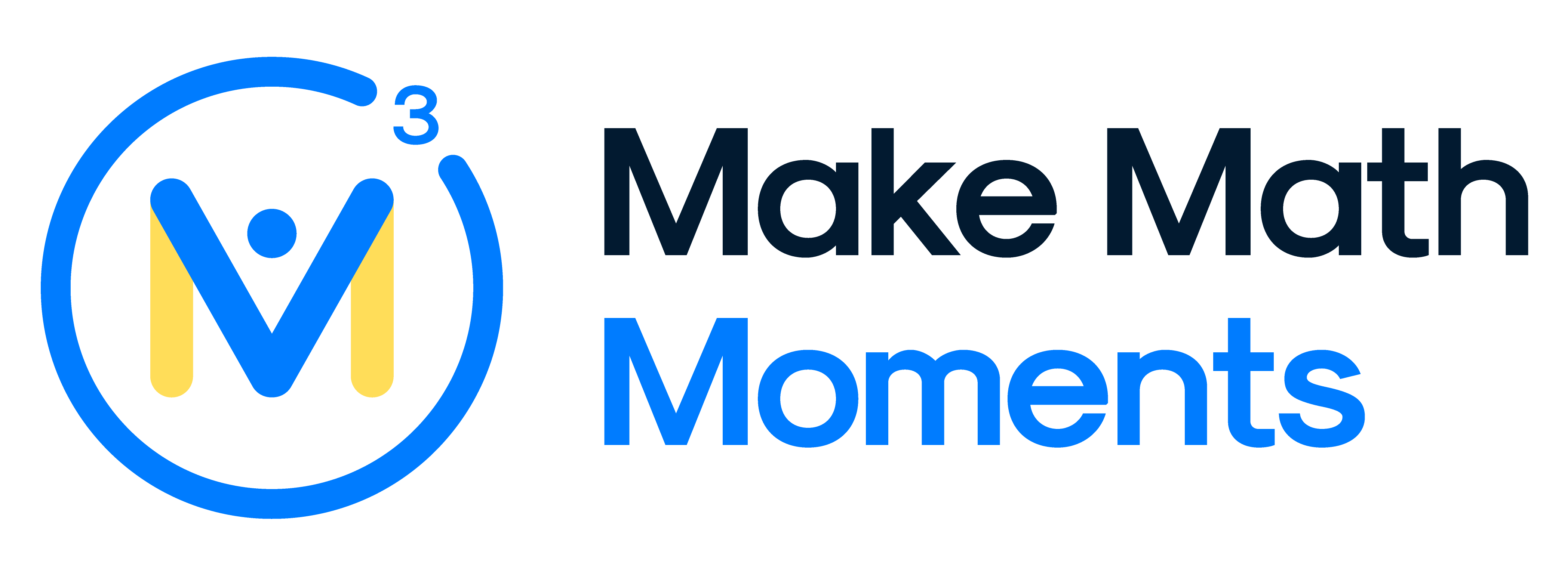



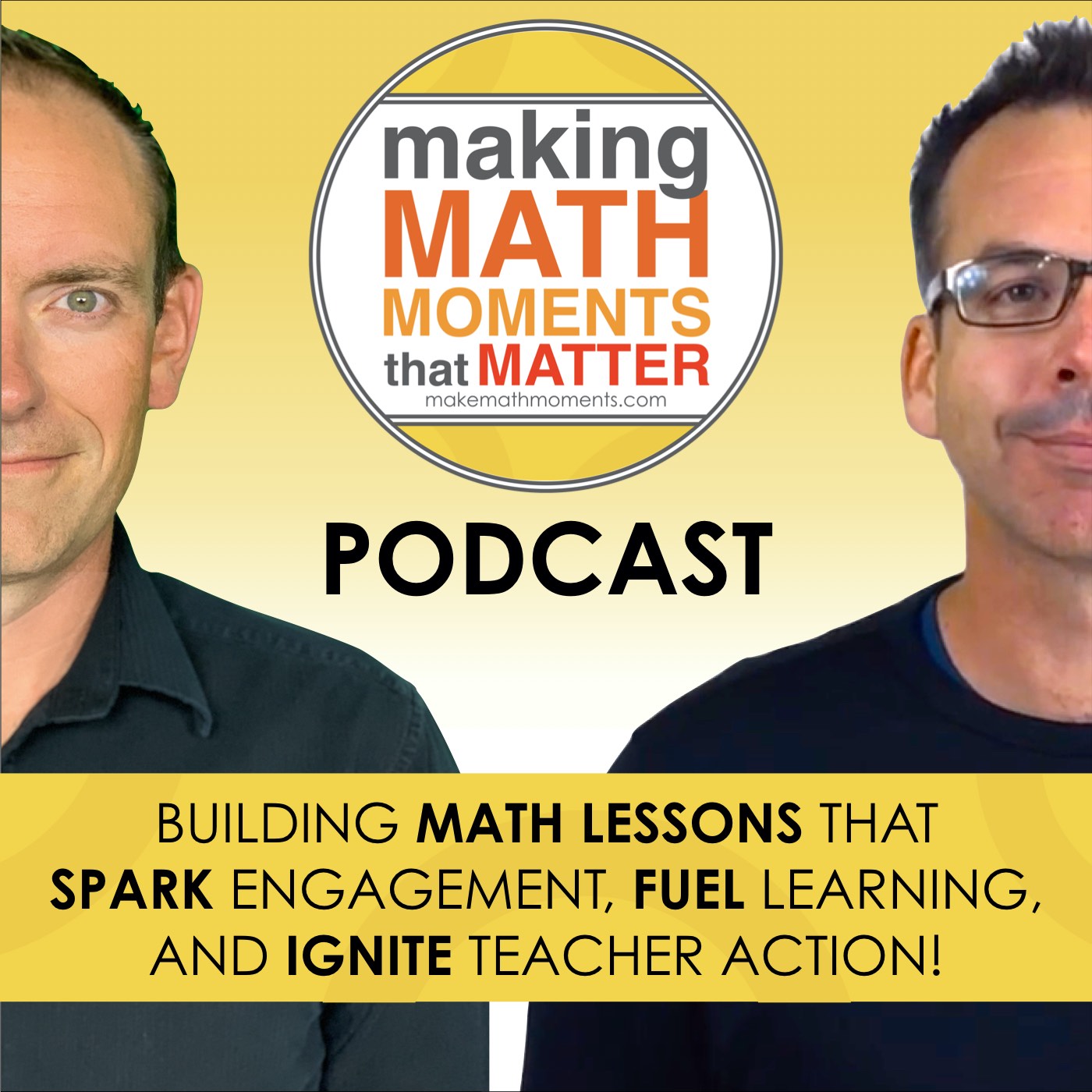


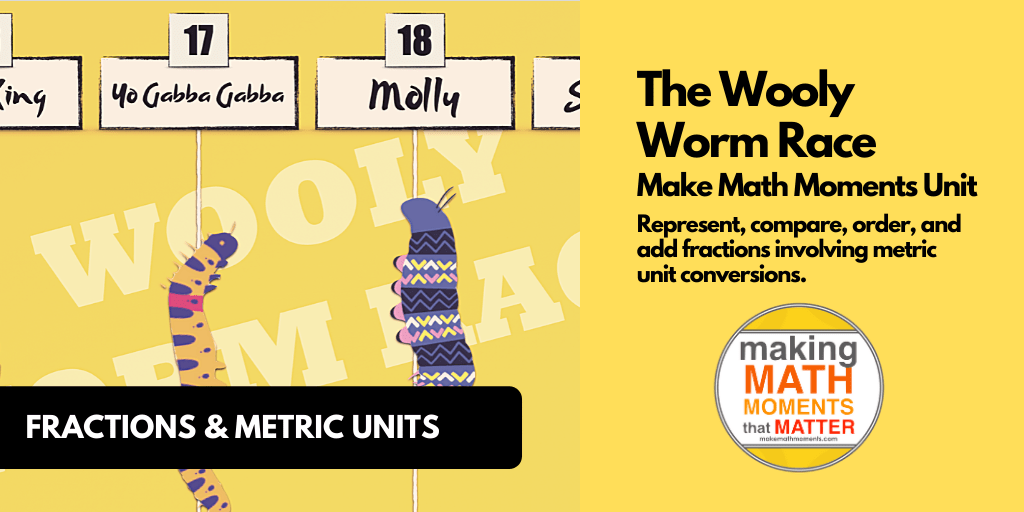
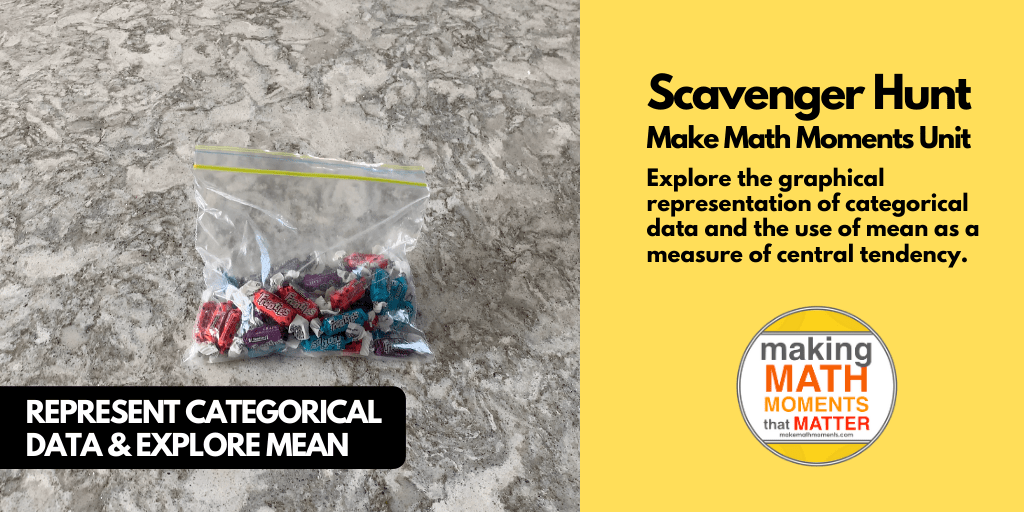

0 Comments